Abstract
To ensure the safety of Kimchi, the safety of Napa cabbage is the most important. Contaminated irrigation water can be a major cause of pathogens during growth of Napa cabbage. The purpose of this study was to investigate the microbial quality of irrigation water used in the cultivation of Napa cabbage. A total of 111 samples including surface water (n = 75) and groundwater (n = 36) collected from four different regions in Korea where Napa cabbage is intensively cultivated were analyzed for a fecal indicator (Escherichia coli) Moreover, 164 E. coli isolates from irrigation water were investigated for pathogenic characteristics including antibiotic resistance, pathogenic genes, serotype, and toxicity using Caenorhabditis elegans. E. coli was detected in 96% of surface water samples and 25% of groundwater samples. The level of E. coli in surface water (0.2–3.2 log MPN/100 mL) was higher than that in groundwater (0–2.0 log MPN/100 mL). When the 164 E. coli isolates were investigated concerning antibiotic resistance, resistance rates were 11.0%, 2.4%, 3.0%, 1.8%, 2.4%, 4.3%, and 3.0% for ampicillin, ampicillin/sulbactam, cefazolin, cefoxitin, gentamicin, levofloxacin, and trimethoprim/sulfamethoxazole, respectively. In addition, 10 (6.1%) of the isolates were positive for the eaeA gene, indicative of enteropathogenic E. coli. Eight of these 10 isolates were obtained from the surface water of the mountainous region II and were toxic to C. elegans. The results indicate the need to manage the microbial risk of irrigation water to enhance the safety of cultivated Napa cabbage.

Similar content being viewed by others
References
Codex (2001) Codex standard for kimchi (CODEX STAN 223-2001). FAO/WHO Joint Publications: Processed and Quick Frozen Fruits & Vegetables. 5A
USA (2008) Health magazine. http://eating.health.com. Updated Feb 1
You JH, Shin MJ, Choi SK (2008) Importance and satisfaction with selection attributes when purchasing kimchi. J East Asian Soc Diet Life 18:624–632
Lee HW, Yoon SR, Kim SJ, Lee HM, Lee JY, Lee JH, Kim S, Ha JH (2017) Identification of microbial communities, with a focus on foodborne pathogens, during kimchi manufacturing process using culture-independent and-dependent analyses. LWT Food Sci Technol 81:153–159
Choi YD, Lee CW, Kim JS, Chung DH, Shim WB (2013) Investigation of hazards from onions and their cultivation areas to establish a good agricultural practices (GAP) model. Korean J Food Sci Technol 45:785–790
Beuchat LR, Farber JM, Garrett EH, Harris LJ, Parish ME, Suslow TV, Busta FF (2001) Standardization of a method to determine the efficacy of sanitizers in inactivating human pathogenic microorganisms on raw fruits and vegetables. J Food Prot 64:1079–1084
Uyttendaele M, Jaykus LA, Amoah P, Chiodini A, Cunliffe D, Jacxsens L, Holvoet K, Korsten L, Lau M, McClure P, Medema G, Sampers I, Jasti PR (2015) Microbial hazards in irrigation water: standards, norms, and testing to manage use of water in fresh produce primary production. Compr Rev Food Sci Food Saf 14:336–356
Castro-Ibáñez I, Gil M, Tudela J, Ivanek R, Allende A (2015) Assessment of microbial risk factors and impact of meteorological conditions during production of baby spinach in the Southeast of Spain. Food Microbiol 49:173–181
Ceuppens S, Hessel CT, de Quadros Rodrigues R, Bartz S, Tondo EC, Uyttendaele M (2014) Microbiological quality and safety assessment of lettuce production in Brazil. Int J Food Microbiol 181:67–76
Decol LT, Casarin LS, Hessel CT, Batista ACF, Allende A, Tondo EC (2017) Microbial quality of irrigation water used in leafy green production in Southern Brazil and its relationship with produce safety. Food Microbiol 65:105–113
Gelting RJ, Baloch MA, Zarate-Bermudez MA, Selman C (2011) Irrigation water issues potentially related to the 2006 multistate E. coli O157: H7 outbreak associated with spinach. Agric Water Manag 98:1395–1402
Park S, Navratil S, Gregory A, Bauer A, Srinath I, Jun M, Szonyi B, Nightingale K, Anciso J, Ivanek R (2013) Generic Escherichia coli contamination of spinach at the preharvest stage: effects of farm management and environmental factors. Appl Environ Microbiol 79:4347–4358
Cooley M, Carychao D, Crawford-Miksza L, Jay MT, Myers C, Rose C, Keys C, Farrar J, Mandrell RE (2007) Incidence and tracking of Escherichia coli O157: H7 in a major produce production region in California. PLoS ONE 2:e1159
Jay MT, Cooley M, Carychao D, Wiscomb GW, Sweitzer RA, Crawford-Miksza L, Farrar JA, Lau DK, O’Connell J, Millington A, Asmundson RV, Atwill ER, Mandrell RE (2007) Escherichia coli O157: H7 in feral swine near spinach fields and cattle, central California coast. Emerg Infect Dis 13:1908–1911
Holvoet K, Sampers I, Seynnaeve M, Uyttendaele M (2014) Relationships among hygiene indicators and enteric pathogens in irrigation water, soil and lettuce and the impact of climatic conditions on contamination in the lettuce primary production. Int J Food Microbiol 171:21–31
Zhang G, Ma L, Phelan VH, Doyle MP (2009) Efficacy of antimicrobial agents in lettuce leaf processing water for control of Escherichia coli O157: H7. J Food Prot 72:1392–1397
Edge T, El-Shaarawi A, Gannon V, Jokinen C, Kent R, Khan I, Koning W, Lapen D, Miller J, Neumann N, Phillips R, Robertson W, Schreier H, Scott A, Shtepani I, Topp E, Wilkes G, Bochove E (2012) Investigation of an Escherichia coli environmental benchmark for waterborne pathogens in agricultural watersheds in Canada. J Environ Qual 41:21–30
Organization WH (1989) Health guidelines for the use of wastewater in agriculture and aquaculture: report of a WHO scientific group (meeting held in Geneva from 18 to 23 November 1987)
Hong EM, Shelton D, Pachepsky YA, Nam WH, Coppock C, Muirhead R (2017) Modeling the interannual variability of microbial quality metrics of irrigation water in a Pennsylvania stream. J Environ Manage 187:253–264
An YJ, Lee WM, Yoon CG (2006) Evaluation of Korean water quality standards and suggestion of additional water parameters. Korean J Ecol Environ 39:285–295
Schierack P, Steinrück H, Kleta S, Vahjen W (2006) Virulence factor gene profiles of Escherichia coli isolates from clinically healthy pigs. Appl Environ Microbiol 72:6680–6686
Kim JY, Kim SH, Kwon NH, Bae WK, Lim JY, Koo HC, Kim JM, Noh KM, Hung WK, Park KT, Park YH (2005) Isolation and identification of Escherichia coli O157: H7 using different detection methods and molecular determination by multiplex PCR and RAPD. J Vet Sci 6:7–19
Wilson-Sanders SE (2011) Invertebrate models for biomedical research, testing, and education. ILAR J 52:126–152
Badyal DK, Desai C (2014) Animal use in pharmacology education and research: The changing scenario. Indian J Pharmacol 46:257–265
Richmond J (2002) Refinement, reduction, and replacement of animal use for regulatory testing: future improvements and implementation within the regulatory framework. ILAR J 43:S63–S68
Leung MC, Williams PL, Benedetto A, Au C, Helmcke KJ, Aschner M, Meyer JN (2008) Caenorhabditis elegans: an emerging model in biomedical and environmental toxicology. Toxicol Sci 106:5–28
Hunt PR (2017) The C. elegans model in toxicity testing. J Appl Toxicol 37:50–59
Sifri CD, Begun J, Ausubel FM, Calderwood SB (2003) Caenorhabditis elegans as a model host for Staphylococcus aureus pathogenesis. Infect Immun 71:2208–2217
Diard M, Baeriswyl S, Clermont O, Gouriou S, Picard B, Taddei F, Denamur E, Matic I (2007) Caenorhabditis elegans as a simple model to study phenotypic and genetic virulence determinants of extraintestinal pathogenic Escherichia coli. Microbes Infect 9:214–223
Son S, Park M, Ryu S, Maburutse B, Oh N, Park J, Oh S, Kim Y (2016) In vivo screening plat form for bacteriocins using Caenorhabditis elegans to control mastitis-causing pathogens. J Dairy Sci 99:8614–8621
Yun B, Jang YJ, Kim YR, Kim H-Y, Kim W-I, Han S, Kim S-R, Ryu S-G, Kim H-J (2017) Virulence profile and antimicrobial resistance of Escherichia coli from flies captured from agricultural environment. J Food Hyg Saf 32:147–153
Kim Y, Mylonakis E (2012) Caenorhabditis elegans immune conditioning with the probiotic bacterium Lactobacillus acidophilus strain NCFM enhances gram-positive immune responses. Infect Immun 80:2500–2508
Brenner S (1974) The genetics of Caenorhabditis elegans. Genetics 77:71–94
Lee JK, Jung DW, Kim YJ, Cha SK, Lee MK, Ahn BH, Kwak NS, Oh SW (2009) Growth inhibitory effect of fermented kimchi on food-borne pathogens. Food Sci Biotechnol 18:12–17
Pagadala S, Marine SC, Micallef SA, Wang F, Pahl DM, Melendez MV, Kline WL, Oni RA, Walsh CS, Everts KL, Buchanan RL (2015) Assessment of region, farming system, irrigation source and sampling time as food safety risk factors for tomatoes. Int J Food Microbiol 196:98–108
US Food and Drug Administration (2017) FSMA final rule on produce safety. Standards for the growing, harvesting, packing, and holding of produce for human consumption
Sayah RS, Kaneene JB, Johnson Y, Miller R (2005) Patterns of antimicrobial resistance observed in Escherichia coli isolates obtained from domestic-and wild-animal fecal samples, human septage, and surface water. Appl Environ Microbiol 71:1394–1404
Chigor VN, Umoh VJ, Smith SI, Igbinosa EO, Okoh AI (2010) Multidrug resistance and plasmid patterns of Escherichia coli O157 and other E. coli isolated from diarrhoeal stools and surface waters from some selected sources in Zaria, Nigeria. Int J Environ Res Public Health 7:3831–3841
Talukdar PK, Rahman M, Rahman M, Nabi A, Islam Z, Hoque MM, Endtz HP, Islam MA (2013) Antimicrobial resistance, virulence factors and genetic diversity of Escherichia coli isolates from household water supply in Dhaka, Bangladesh. PLoS ONE 8:e61090
Lim S, Lee H, Byun J, Park S, Jung S (2007) Antimicrobial resistance of commensal bacteria isolated from food-producing animals I. Antimicrobial resistance of Escherichia coli and Enterococcus spp. isolated from cattle faecal samples. Korean J Vet Public Health 31:21–29
Kim A, Cho Y, Lim S, Her M, Jeong W, Jung S, Kown J (2007) Antimicrobial resistance of commensal bacteria isolated from food-producing animals III. Antimicrobial resistance of Escherichia coli and Enterococcus spp. isolated from chicken faecal samples. Korean J Vet Public Health 31:4–49
Jeong KO, Heo JH, Lee JM, Yun IR, Choi YJ, Kim JS (2010) Surveillance of antimicrobial resistance ratio of E. coli and Enterococcus spp. isolated from fecal and carcasses of pigs in slaughterhouse. Korean J Vet Serv 33:241–248
Lee JI, Han GY, Park HH (2003) Characteristics and antibiotics susceptibility of Escherichia coli isolated from fishery products. Korean J Food Nutr 16:111–115
Oh H, Park J (2009) Characteristics of antibiotic resistant bacteria in urban sewage and river. J Korean Soc Environ Eng 31:232–239
Cho JI, Joo IS, Park KS, Han MK, Son NR, Jeong SJ, Heo J, Kim YJ, Oh MH, Kim SH, Lee SH (2014) Characterization of pathogenic Escherichia coli strains linked to an outbreak associated with kimchi consumption in South Korea, 2012. Food Sci Biotechnol 23:209–214
Merkx-Jacques A, Coors A, Brousseau R, Masson L, Mazza A, Tien Y-C, Topp E (2013) Evaluating the pathogenic potential of environmental Escherichia coli by using the Caenorhabditis elegans infection model. Appl Environ Microbiol 79:2435–2445
Canada Health (2000) Waterborne outbreak of gastroenteritis associated with a contaminated municipal water supply, Walkerton, Ontario, May–June 2000. Can Commun Dis Rep 26:170–173
Greig J, Rajic A, Yong I, Mascarenhas M, Waddell L, Lejeune J (2015) A scoping review of the role of wildlife in the transmission of bacterial pathogens and antimicrobial resistance to the food chain. Zoonoses Public Health 62:269–284
Allende A, Monaghan J (2015) Irrigation water quality for leafy crops: a perspective of risks and potential solutions. Int J Environ Res Public Health 12:7457–7477
Acknowledgments
This study was carried out with the support of the Research Program for Agricultural Science and Technology Development (Project No. PJ012009), and the National Institute of Agricultural Sciences, Rural Development Administration, Republic of Korea.
Author information
Authors and Affiliations
Corresponding author
Rights and permissions
About this article
Cite this article
Yun, B., Kim, Y., Hung, N.B. et al. Microbiological quality and characteristics of isolated Escherichia coli in irrigation water used in Napa cabbage cultivation. Appl Biol Chem 61, 567–574 (2018). https://doi.org/10.1007/s13765-018-0393-1
Received:
Accepted:
Published:
Issue Date:
DOI: https://doi.org/10.1007/s13765-018-0393-1




